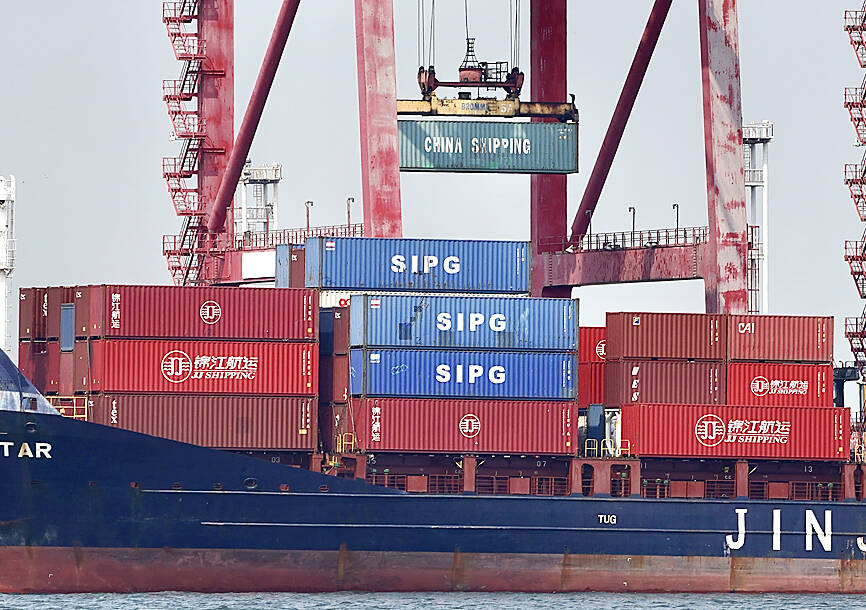Growth in export orders returned to positive territory for the first time in seven quarters last quarter, thanks to rising demand for chips used in artificial intelligence (AI) applications and high-performance computing (HPC) applications, the Ministry of Economic Affairs said yesterday.
Export orders in the April-to-June quarter expanded 6.95 percent annually from US$132.35 billion a year earlier to US$141.55 billion, after orders last month grew slower than expected at 3.1 percent year-on-year amid weak demand for notebook computers and smartphones, the ministry said.
The ministry said it had expected an annual expansion of at least 10.9 percent.

Photo: CNA
During the first half of this year, export orders rose 2.3 percent to US$274.86 billion, compared with US$268.56 billion a year ago, it said.
“The latest data re-enforced our confidence that export orders are back to a recovery mode and expected to grow steadily in the second half of the year,” Department of Statistics Director Huang Yu-ling (黃于玲) said via telephone. “Restocking demand before the shopping season also helps.”
The ministry forecast export orders this month to reach US$46.5 billion to US$48.5 billion, representing an annual decline of 2.6 percent to a growth of 1.6 percent, Huang said, attributing the slight improvement to a higher comparison base in July last year.
Orders of information and communications technology products last month increased 3.6 percent annually to US$12.74 billion, backed by robust demand for AI applications, and cloud-based devices and servers. During the first six months, orders sank 1.5 percent to US$77.49 billion.
Orders of electronic products rose 6.3 percent to US$15.54 billion last month, primarily fueled by robust demand for foundry services, AI-related applications and HPC devices, the ministry said. Orders in the first six months jumped 10.4 percent to US$96.69 billion.
Orders for optoelectronics products expanded 5.8 percent to US$1.79 billion last month, attributable to increases in demand for camera lens modules and optronic inspection tools, as the US and Europe boosted semiconductor manufacturing equipment spending. Orders jumped 11 percent to US$9.91 billion in the first half.
Orders of base metals orders rose 2.5 percent to US$2.1 billion last month, thanks to improving demand for stainless steel and copper foils, the ministry said. However, orders in the first half fell 0.3 percent to US$12.84 billion.
Orders of machinery goods climbed 3.4 percent to US$1.67 billion last month due to better demand for new manufacturing equipment, but orders in the first half dipped 3.8 percent to US$9.51 billion, the ministry said.
Orders of plastic products increased 2.7 percent to US$1.6 billion on higher average selling prices and rising inventory restocking demand. Orders expanded 1.7 percent to US$9.58 billion in the first two quarters, it said.
Lastly, orders for petrochemical products grew 9.5 percent last month to US$1.6 billion, as higher global crude oil prices helped boost product prices. Orders rose 5.6 percent to US$9.27 billion in the first half, the ministry said.

Semiconductor shares in China surged yesterday after Reuters reported the US had ordered chipmaking giant Taiwan Semiconductor Manufacturing Co (TSMC, 台積電) to halt shipments of advanced chips to Chinese customers, which investors believe could accelerate Beijing’s self-reliance efforts. TSMC yesterday started to suspend shipments of certain sophisticated chips to some Chinese clients after receiving a letter from the US Department of Commerce imposing export restrictions on those products, Reuters reported on Sunday, citing an unnamed source. The US imposed export restrictions on TSMC’s 7-nanometer or more advanced designs, Reuters reported. Investors figured that would encourage authorities to support China’s industry and bought shares

FLEXIBLE: Taiwan can develop its own ground station equipment, and has highly competitive manufacturers and suppliers with diversified production, the MOEA said The Ministry of Economic Affairs (MOEA) yesterday disputed reports that suppliers to US-based Space Exploration Technologies Corp (SpaceX) had been asked to move production out of Taiwan. Reuters had reported on Tuesday last week that Elon Musk-owned SpaceX had asked their manufacturers to produce outside of Taiwan given geopolitical risks and that at least one Taiwanese supplier had been pushed to relocate production to Vietnam. SpaceX’s requests place a renewed focus on the contentious relationship Musk has had with Taiwan, especially after he said last year that Taiwan is an “integral part” of China, sparking sharp criticism from Taiwanese authorities. The ministry said

US President Joe Biden’s administration is racing to complete CHIPS and Science Act agreements with companies such as Intel Corp and Samsung Electronics Co, aiming to shore up one of its signature initiatives before US president-elect Donald Trump enters the White House. The US Department of Commerce has allocated more than 90 percent of the US$39 billion in grants under the act, a landmark law enacted in 2022 designed to rebuild the domestic chip industry. However, the agency has only announced one binding agreement so far. The next two months would prove critical for more than 20 companies still in the process

CHANGING JAPAN: Nvidia-powered AI services over cellular networks ‘will result in an artificial intelligence grid that runs across Japan,’ Nvidia’s Jensen Huang said Softbank Group Corp would be the first to build a supercomputer with chips using Nvidia Corp’s new Blackwell design, a demonstration of the Japanese company’s ambitions to catch up on artificial intelligence (AI). The group’s telecom unit, Softbank Corp, plans to build Japan’s most powerful AI supercomputer to support local services, it said. That computer would be based on Nvidia’s DGX B200 product, which combines computer processors with so-called AI accelerator chips. A follow-up effort will feature Grace Blackwell, a more advanced version, the company said. The announcement indicates that Softbank Group, which until early 2019 owned 4.9 percent of Nvidia, has secured a